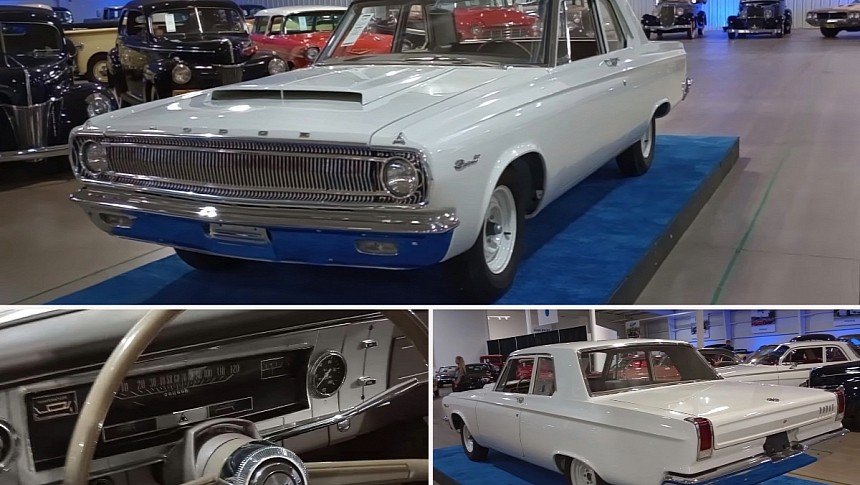Introduced in 1949 as the company's range-topping full-size car, the Dodge Coronet soldiered until 1959. Chrysler revived the nameplate in 1965 as a midsize vehicle to compete in the newly established intermediate segment. The fifth-generation Coronet famously spawned the Charger and the Super Bee.
Overshadowed by its muscle car siblings, the Coronet is rarely associated with high performance. However, the Coronet was an integral part of the muscle car wars, being offered with both the 440-cubic-inch (7.2-liter) Magnum and the 426-cubic-inch (7.0-liter) HEMI. The Coronet was, in fact, one of the first Mopars available with the mighty HEMI. And contrary to popular belief, it was the first Dodge to get the R/T package. It happened in 1967, one full year before the Charger R/T became a thing.
But I can give you another reason why the Coronet is an underrated gem. Unlike the Charger and the Super Bee, the Coronet also spawned a factory dragster for the Super Stock class. Born in 1965 and available either as a two-door sedan or hardtop, the drag-spec Coronet looked like a regular production model at first glance, save for the scooper hood. But it left the assembly line with a plethora of weight-saving features.
As the Super Stock class did not allow fiberglass body panels at the time, Chrysler resorted to acid dipping. The process reduced the thickness of the hood, doors, fenders, and bumper by more than 60%. The A990 package also included thinner glass and a one-inch shorter wheelbase. Dodge also got rid of all the convenience features that added unnecessary weight, including the AC, radio, trim panels, carpets, and even the back seat.
The regular front seats were also ditched, replaced by bucket seats from the Dodge A100 van bolted on aluminum frames with holes in them. The 426 HEMI V8 under the hood was different, too. The Street HEMI engine was still a few months away, so Dodge used a modified version of the racing engine that dominated the drag racing scene a year before. Transmission options included a four-speed manual or a TorqueFlite automatic, both of the race-ready, heavy-duty variety.
Dodge built 101 examples, a run that also included a handful of altered-wheelbase cars. Plymouth also made an identical variant of the Belvedere that year. Both cars are obviously super rare today since many of them were raced and wrecked or had their internals replaced over the years. The white example you see here is one of those lucky examples that survived.
Restored to a perfect factory finish, this Coronet A990 is still highly original. It retains all of its factory body panels, glass, radiator, and exhaust system, while the HEMI engine was completely rebuilt by Wheeler Racing Engines of Minneapolis. It still has the original 727 TorqueFlite transmission and the rear axle. A few components, such as the door panels, have been replaced, but it's still one of the most factory-correct A990 restorations out there.
And needless to say, the white finish and matching steel wheels make it the perfect sleeper. Check it out in the video below.
But I can give you another reason why the Coronet is an underrated gem. Unlike the Charger and the Super Bee, the Coronet also spawned a factory dragster for the Super Stock class. Born in 1965 and available either as a two-door sedan or hardtop, the drag-spec Coronet looked like a regular production model at first glance, save for the scooper hood. But it left the assembly line with a plethora of weight-saving features.
As the Super Stock class did not allow fiberglass body panels at the time, Chrysler resorted to acid dipping. The process reduced the thickness of the hood, doors, fenders, and bumper by more than 60%. The A990 package also included thinner glass and a one-inch shorter wheelbase. Dodge also got rid of all the convenience features that added unnecessary weight, including the AC, radio, trim panels, carpets, and even the back seat.
The regular front seats were also ditched, replaced by bucket seats from the Dodge A100 van bolted on aluminum frames with holes in them. The 426 HEMI V8 under the hood was different, too. The Street HEMI engine was still a few months away, so Dodge used a modified version of the racing engine that dominated the drag racing scene a year before. Transmission options included a four-speed manual or a TorqueFlite automatic, both of the race-ready, heavy-duty variety.
Dodge built 101 examples, a run that also included a handful of altered-wheelbase cars. Plymouth also made an identical variant of the Belvedere that year. Both cars are obviously super rare today since many of them were raced and wrecked or had their internals replaced over the years. The white example you see here is one of those lucky examples that survived.
Restored to a perfect factory finish, this Coronet A990 is still highly original. It retains all of its factory body panels, glass, radiator, and exhaust system, while the HEMI engine was completely rebuilt by Wheeler Racing Engines of Minneapolis. It still has the original 727 TorqueFlite transmission and the rear axle. A few components, such as the door panels, have been replaced, but it's still one of the most factory-correct A990 restorations out there.
And needless to say, the white finish and matching steel wheels make it the perfect sleeper. Check it out in the video below.








